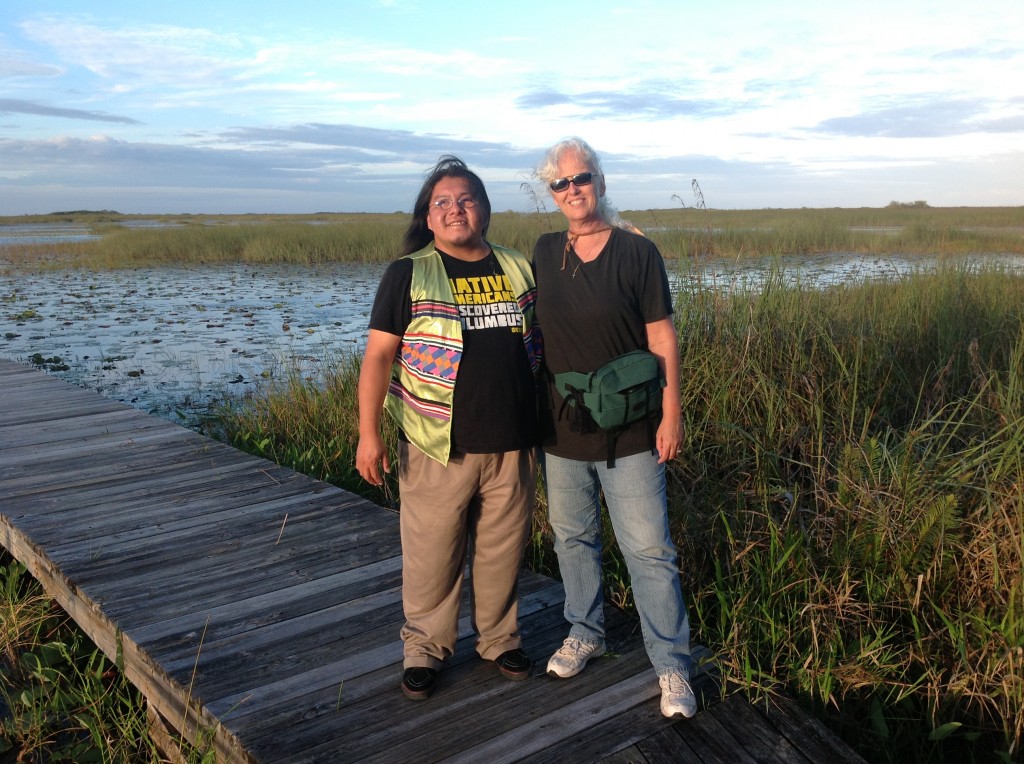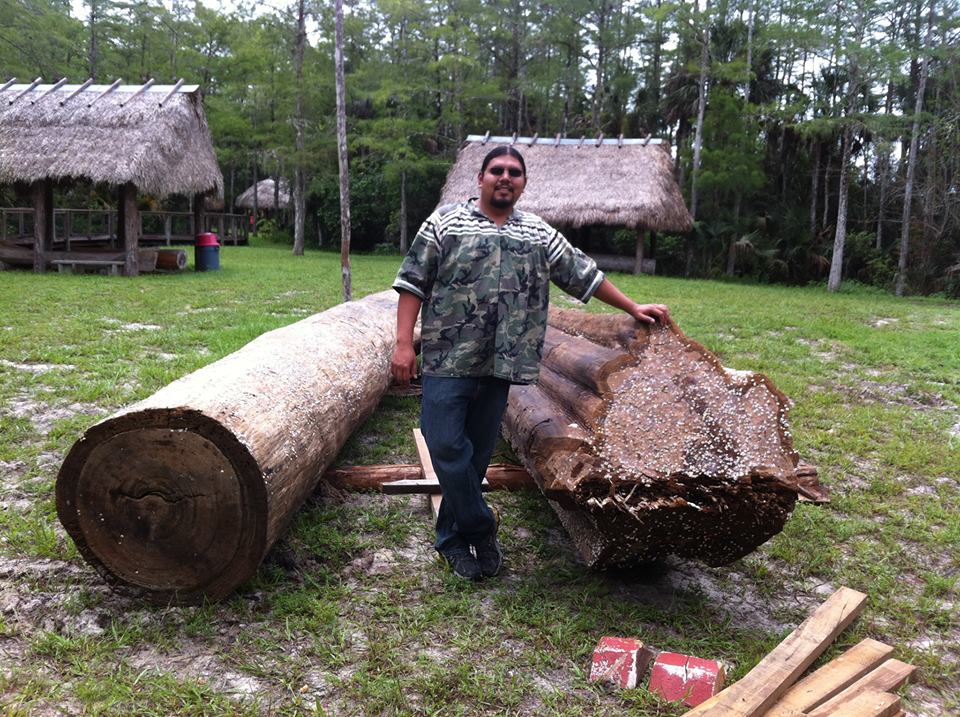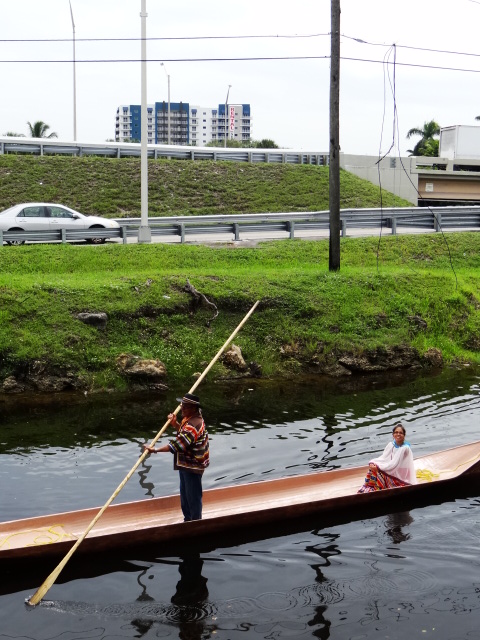
Robin Haines Merrill
Robin Haines Merrill aims to preserve the traditional art form of dugout canoes by organizing a seasonal Paddle Up, featuring Seminole and Miccosukee canoes. From her missionary work in Manila’s seedy sex industry to Inner Mongolia, Robin Haines Merrill, a recent Knight Arts Challenge grantee, has preserved and fostered the art of human decency. I’m not qualified to judge if Merrill has changed the world, but she has definitely changed lives and rescued souls from certain death. Now, Merrill is going to transform South Florida by revitalizing a tradition that binds all of us to its watery landscape and highlight the heritage of Seminole, Miccosukee and other Florida tribes.
Neil de la Flor: Who is Robin Haines Merrill?
Robin Haines Merrill: I’m an artist and missionary Christian. I’m an unexpected resident of South Florida due to being uprooted from Southeast Asia for medical reasons. I lived and worked in the Philippines among the poor for 15 years, and spent time in China and Inner Mongolia on various cultural exchanges. I have lung damage and nerve damage from pollution, and received medical treatment here in South Florida, where it was determined I could not return to my home and work overseas. We ended up staying in the Fort Lauderdale area. As a Jesus-follower, I have a passion for love and social justice, and tend to take a simplistic view on the guts of the gospel, and live it out fearlessly. Albeit peculiarly.
ND: Why peculiarly?
RHM: My “modus operandi” as a Christian and a missionary is to walk and pray. I was trained well at the US Center for World Mission & Fuller Seminary and attended many prayer walks. I was convinced about the effects of being faithful and expectant and relying on God’s power while prayerfully walking and praying over an area, reading and meditating on scripture. While in Manila, I ministered for a decade in a horrid red light district called Ermita with other Christian groups. We walked the streets for years, just being light in the midst of incredible darkness, and trusted God for our feeble acts of care and love to others. God moved mightily and ‘took out’ that entire region when a new political leader came in and shut down the worst bars. It seemed like a miracle to everyone involved, and we felt uplifted in how we approached the problem. Since then, I have had a habit of walking and praying expectantly.
Robin Haines Merrill (right).
ND: What drew you into the Seminole and Miccosukee cultures?
RHM: When I was grounded in South Florida for medical reasons, I continued the work of the ministry by setting up the retail shop of Mission Gifts Fair Trade, selling the products of our brothers and sisters who have escaped from the sex industry from around the world. Unfortunately, although Las Olas Boulevard looks fantastic on the surface, once I started working there, I noticed how much “doesn’t work.”
I needed to succeed for “my people,” the folks that I represent, so I set out walking and praying over the area. I kept being disturbed by a massacre monument in the quaint Colee Hammock Park behind our gallery. The marker commemorated a massacre that was an impetus for the second Seminole War. I know that the “blood will cry out from the soil,” as the Bible says. But I assumed after more than a hundred years, that either the Seminole tribe or the two local churches next to the site had performed a cleansing ceremony to heal the land. I had been involved in various cleansing ceremonies as a missionary in the Philippines, and had been asked to come and pray for an area to be cleared of evil spirits.
Pedro with two logs.
ND: How did you get involved with the traditional art form of creating dugout canoes and with the larger Seminole and Miccosukee culture?
RHM: After a few years in Fort Lauderdale, I realized that not many people thought the way that I do, and that more than likely, no one had performed any rituals or prayers to cleanse this land. So I did it myself, but one day a dear lady had the gumption to join me in walking the neighborhood and anointing certain areas with oil. Very quickly after anointing that area with oil, things just opened up. For one, I was informed by a local historian that the massacre never occurred there, that the monument was in fact wrongly placed there. Well, I thought God had a real keen way of cleansing that soil, by revealing that it never happened to begin with! Then, I had the chance to meet a real Seminole, by taking a trip sponsored by the Stranahan House. After the river tour I approached the tour guide, Everett Osceola, and asked him to come and visit me at the gallery so I could explain the visions I had.
I took him on a walking tour and told him what I could foresee as possibilities for the region. I’m sure I sounded like a crazy woman babbling, but fortunately he had the nerve to step out and invite others to come and see and hear the ideas and visions that I had for that area, that involved the Seminoles and trying to tie in their legacy of the land to an urban renewal project. That led to the rally to Save the Post Office, which has been chronicled at www.savethelasolaspostoffice.blogspot.com.
ND: Has the changing landscape—the environment, global climate change and fundamental changes within these cultures—impacted traditional art forms like dugout canoes?
RHM: The canoes often used by the tribes today are actually replicas of classic dugout canoes, and are made from fiberglass. The one we used for the post office rally was a fiberglass replica, and it was so heavy and hard to lift it took many men to move it. Aluminum and fiberglass canoes are more practical than cypress logs, and the art of creating a dugout from a log is quickly being lost. Therefore, this event will help ignite renewed interest, especially amongst the next generation of able bodied people. It takes a lot of brute force to carve and chop a log. Many of the cypress trees that are large enough to create a canoe from, no longer exist due to logging, deforestation and environmental issues. Unnatural high water levels from the controlled levee system has caused root-rot in the hammocks of the Everglades and many old growth trees have been lost. And of course, with the advent of the automobile and gas powered air boats, canoes are unnecessary as they once were as a form of transportation.
Canoe and Miami traffic.
Our project will be highlighting dugout canoes as an art and craft form. The waterways are still the life veins of the state of Florida and having respect and knowledge of the water and the water’s health is an important asset. The Paddle Up event we will be staging will spotlight our connectedness via the waterways. The Himmarshee Canal and New River of Fort Lauderdale are connected to the Everglades. We are all connected via water.
ND: Tell us about Pedro Zepeda?
RHM: Pedro Zepeda is a traditional Seminole artist who helped lead the canoe event that was a part of the rally. The year after the Post Office Rally, I heard that a renewed interest was kindled amongst tribal members to create and use the canoes. That was the incubator for my quest to further the canoe craft and its inclusion in our larger vision for urban and cultural renewal. Pedro worked for years at the AhTahThiKi Museum in Big Cypress Reservation and is now an independent artist working in traditional Seminole arts. He will be our lead artist and we anticipate Leroy Henehayo Osceola from the Sovereign Miccosukee Seminole Tribe (Independents) to join us as well. We are very fortunate to have two of the best in canoe craft available to travel and join us during 2014 to carve a canoe in downtown Fort Lauderdale.
ND: The Seminoles have an interesting history.
RHM: I asked the Seminoles to join me in the rally to save the post office because they are the only undefeated tribe in US history. The Federal government was trying to shut down our local post office, which we sorely need in a walkable, urban downtown. When I began to learn about the Seminole history, I realized that they continuously fought the US government and won. In fact, they won three wars with the US government, and it’s the first war the US ever lost. It was the first war the US Marines ever lost. Who better to call when you are fighting the US government than the undefeated Seminoles?!
While in line at the Las Olas post office, I would stare at an historic photo on the wall of Seminoles in canoes on the New River. I created the idea of bringing them in on this public art performance piece I did as a rally to preserve and retain our local post office. And we won! Our case was hopeless, the Las Olas Post Office was slated for the chopping block, but I thought at least we can gather together as a community to make an attempt to save it, and if we lose, it will have been a funeral of sorts. But to do nothing was not an option. The Friendship Dance, which we did after the canoe arrived, was also electrifying, and hit nerves within the community that I heard about repeatedly afterward. “When are you going to do the next event?”, people would say to me, and I realized that there was a deep need to create new and exciting ritual-type civic events that hit on core topics like dance, craftsmanship and traditional arts.
ND: Why is it important to spread/share this tradition with non-native cultures?
RHM: Craftsmanship is important for all cultures. The art of learning a craft is something that is time consuming, and cannot be “downloaded.” Unlike taking a course online, a craft is best learned in a traditional master-apprentice mode. Today, people’s way of thinking is getting reduced to sound bytes and speed. A dugout canoe, weaving or sewing a garment, and basket making are art forms that are not going to make someone wealthy, yet are important to encourage the next generation to take on as a virtue. The value we place on craft-making and artistic ventures is critical to society.
ND: What’s the connection between dugout canoes and the neighborhood revitalization project Las Olas Village?
RHM: My theological approach in the Las Olas Village urban renewal project, and the integration of the Seminole/Miccosukee designs, is about basic humanity. The Paddle Up event will be all manpowered watercraft, such as paddleboards, kayaks and canoes. No motorized vessels will be allowed, so as to ensure the safety of people who are more vulnerable. This lends itself to the project on the street of Las Olas, which is concerned with enhancing pedestrian safety, and bicycles as well. Cars and the people operating them have become a deadly force in downtown Fort Lauderdale, as in Miami-Dade County. South Florida suffers from being one of the worst in the nation for vehicle fatalities, pedestrian deaths and bicycle fatalities. It is also ranked as one of the rudest areas in the United States. I believe all this can change when it is faced directly and strategically. For me, prayer is the foremost component to change. And in that same type of attitude and approach, I would like to create art that helps bring about change in society.
ND: What’s next?
RHM: “Love the Lord your God with all your heart, with all your mind, with all your soul, and with all your strength, and Love your Neighbor as yourself.” These are the two greatest commandments Jesus told as a reply to someone who asked Him what to do in life to be healthy. I will spend my entire life living out these rudimentary scriptures, and this is what I enjoin others to do as well. The Las Olas Village project is a response to the lack of human decency that I have encountered, and my attempt as an artist to help bring about change and restoration. The Knight Foundation Challenge Grant will enable us to begin the dugout canoe portion of the urban renewal project, which of course we hope will begin to change hearts and minds as well.
ND: Favorite meal?
RHM: Water.
Visit Merrill’s The Upper Room Art Gallery, a nonprofit global collective of artists and designers whose artwork specializes in organic and recycled materials and who are concerned about social justice, global poverty and environmental issues.
Recent Content
-
Artsarticle ·
-
Artsarticle ·
-
Artsarticle ·



